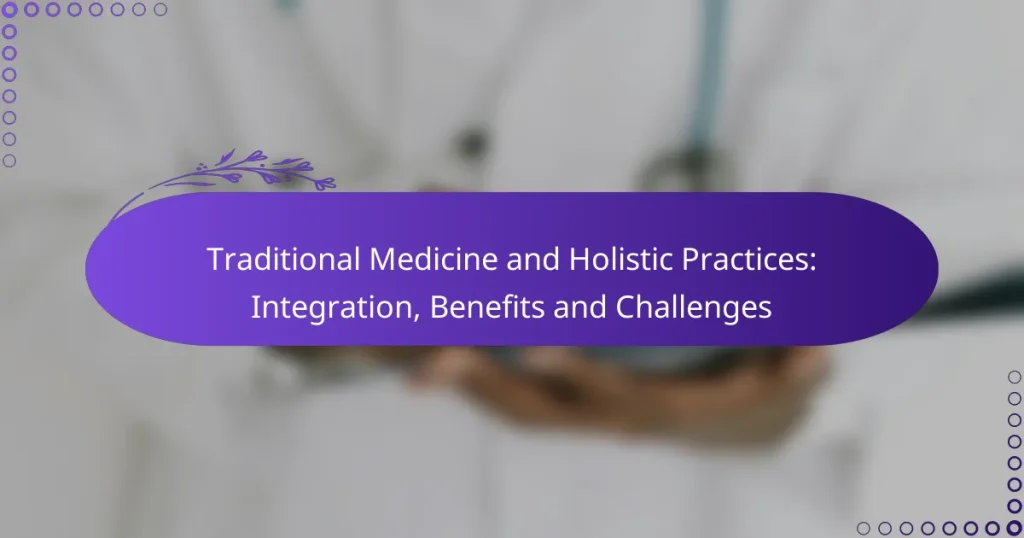The integration of traditional medicine and holistic practices into healthcare represents a promising approach to enhancing patient outcomes by addressing a wide range of physical, emotional, and spiritual needs. While this combination offers numerous benefits, such as improved health outcomes and greater patient satisfaction, it also faces challenges like lack of standardization and misconceptions among healthcare professionals that can impede its acceptance in mainstream systems.

How can traditional medicine and holistic practices be integrated in healthcare?
Integrating traditional medicine and holistic practices into healthcare involves combining conventional medical approaches with alternative therapies to enhance patient outcomes. This integration can improve overall health by addressing physical, emotional, and spiritual needs.
Collaborative care models
Collaborative care models facilitate teamwork among healthcare providers from various disciplines, including traditional and holistic practitioners. This approach allows for shared decision-making and comprehensive treatment plans that consider diverse healing methods.
For example, a patient with chronic pain might receive acupuncture from a traditional practitioner while also undergoing physical therapy. This synergy can lead to more effective pain management and improved patient satisfaction.
Interdisciplinary training programs
Interdisciplinary training programs prepare healthcare professionals to understand and respect both traditional and holistic practices. These programs can include workshops, seminars, and courses that cover various healing modalities and their applications in patient care.
Such training encourages healthcare providers to communicate effectively with each other, fostering a more integrated approach to treatment. This can help reduce skepticism and promote collaboration among practitioners.
Patient-centered approaches
Patient-centered approaches prioritize the individual needs and preferences of patients, allowing them to participate actively in their healthcare decisions. This method encourages open discussions about the benefits and risks of both traditional and holistic treatments.
For instance, a patient may choose to combine herbal remedies with prescribed medications, provided they are informed about potential interactions. Empowering patients in this way can lead to better adherence to treatment plans and improved health outcomes.
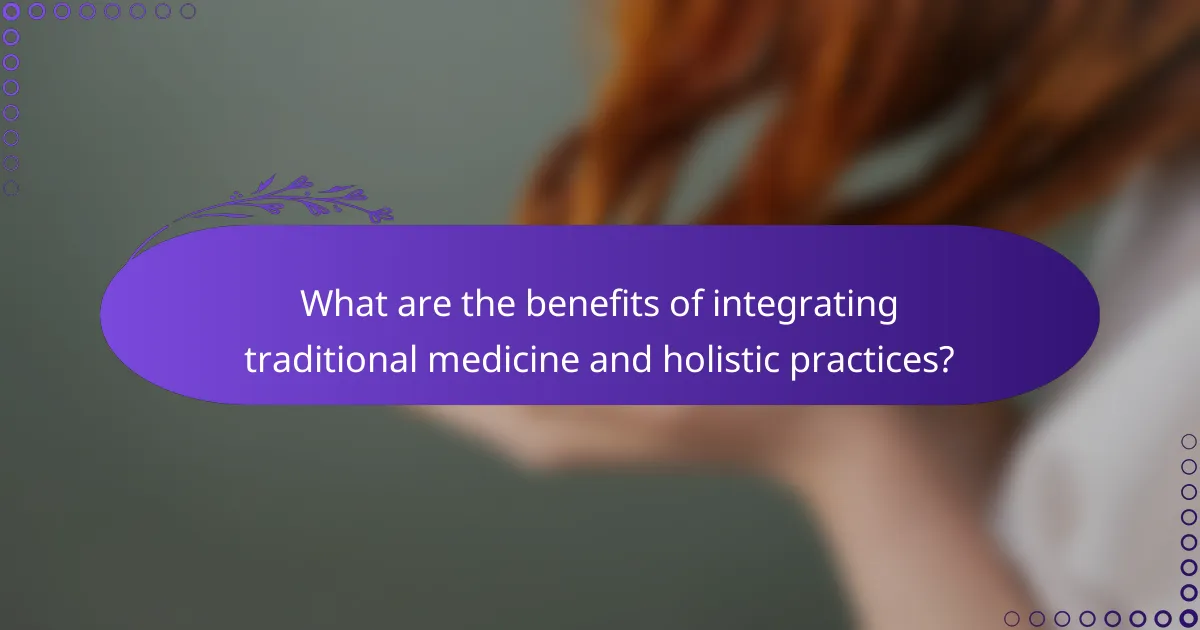
What are the benefits of integrating traditional medicine and holistic practices?
Integrating traditional medicine and holistic practices offers numerous benefits, including improved health outcomes, greater patient satisfaction, and potential cost savings. By combining these approaches, patients often receive more comprehensive care tailored to their individual needs.
Improved patient outcomes
Integrating traditional medicine with holistic practices can lead to better patient outcomes by addressing both physical and mental health. For example, combining herbal remedies with mindfulness techniques may enhance recovery from chronic illnesses. This multifaceted approach often results in more effective treatment plans that consider the whole person.
Patients may experience reduced symptoms and improved quality of life when both traditional and holistic methods are utilized. This can be particularly beneficial for conditions like anxiety, where combining therapy with herbal supplements may yield better results than either method alone.
Enhanced patient satisfaction
Patients often report higher satisfaction levels when they receive integrated care that respects their cultural beliefs and personal preferences. Traditional medicine practices, such as acupuncture or herbal treatments, can complement conventional therapies, making patients feel more involved in their healthcare decisions.
Moreover, holistic practices like yoga or meditation can empower patients to take an active role in their healing process. This sense of agency can lead to a more positive healthcare experience, fostering trust and communication between patients and providers.
Cost-effectiveness in treatment
Integrating traditional medicine and holistic practices can be cost-effective, potentially reducing overall healthcare expenses. For instance, preventative measures such as dietary changes and stress management techniques can lower the need for more expensive medical interventions later on.
Additionally, many traditional remedies are less expensive than pharmaceutical options, making them accessible to a broader range of patients. By focusing on prevention and holistic care, healthcare systems may find that they can allocate resources more efficiently, ultimately benefiting both patients and providers.
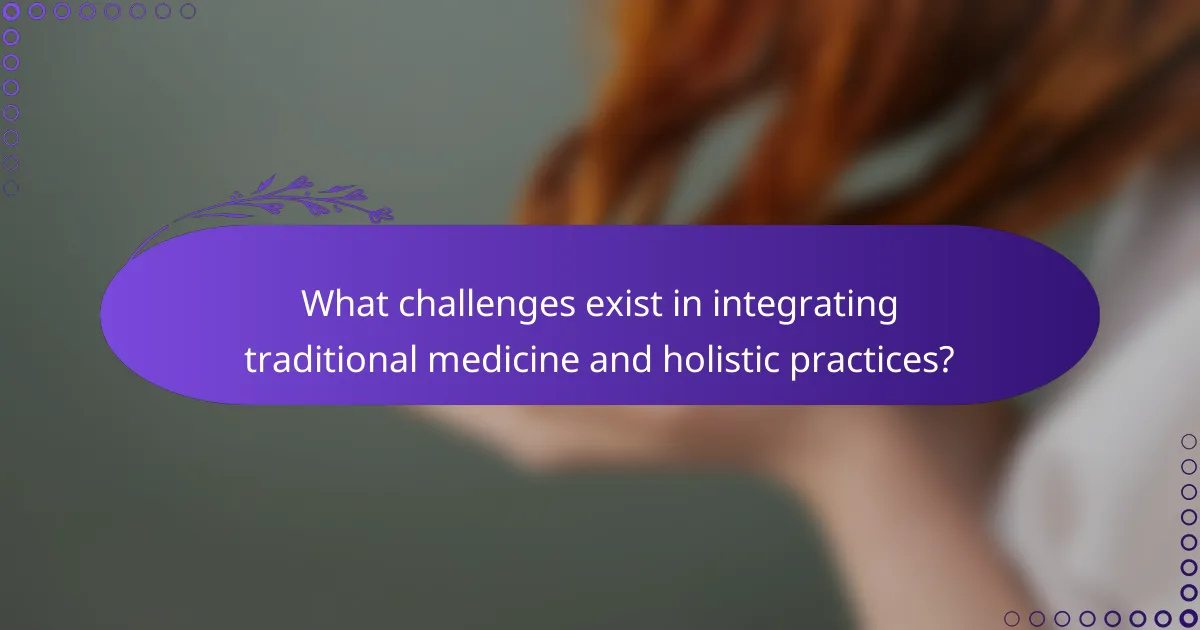
What challenges exist in integrating traditional medicine and holistic practices?
Integrating traditional medicine and holistic practices faces several challenges, including lack of standardization, regulatory hurdles, and misconceptions among healthcare professionals. These obstacles can hinder effective collaboration and acceptance within mainstream healthcare systems.
Lack of standardization
The absence of standardized practices in traditional medicine and holistic approaches complicates their integration into conventional healthcare. Different cultures and regions may have varying methods, dosages, and treatment protocols, making it difficult to establish a unified framework.
For example, herbal remedies can differ significantly in potency and preparation methods, leading to inconsistencies in patient outcomes. Establishing clear guidelines and protocols could enhance reliability and safety in treatment.
Regulatory hurdles
Regulatory challenges often impede the acceptance of traditional medicine and holistic practices within formal healthcare systems. Many countries have strict regulations governing medical practices, which may not accommodate alternative therapies.
In the United States, for instance, the Food and Drug Administration (FDA) has specific requirements for the approval of herbal supplements and alternative treatments, which can be a lengthy and complex process. Navigating these regulations requires careful attention to compliance and safety standards.
Misconceptions among healthcare professionals
Many healthcare professionals may hold misconceptions about traditional medicine and holistic practices, viewing them as unscientific or ineffective. This skepticism can lead to reluctance in referring patients to these therapies or collaborating with practitioners.
Education and training programs that include information on the benefits and evidence supporting these practices can help bridge the gap. Encouraging open dialogue between traditional and conventional practitioners can foster mutual respect and understanding.
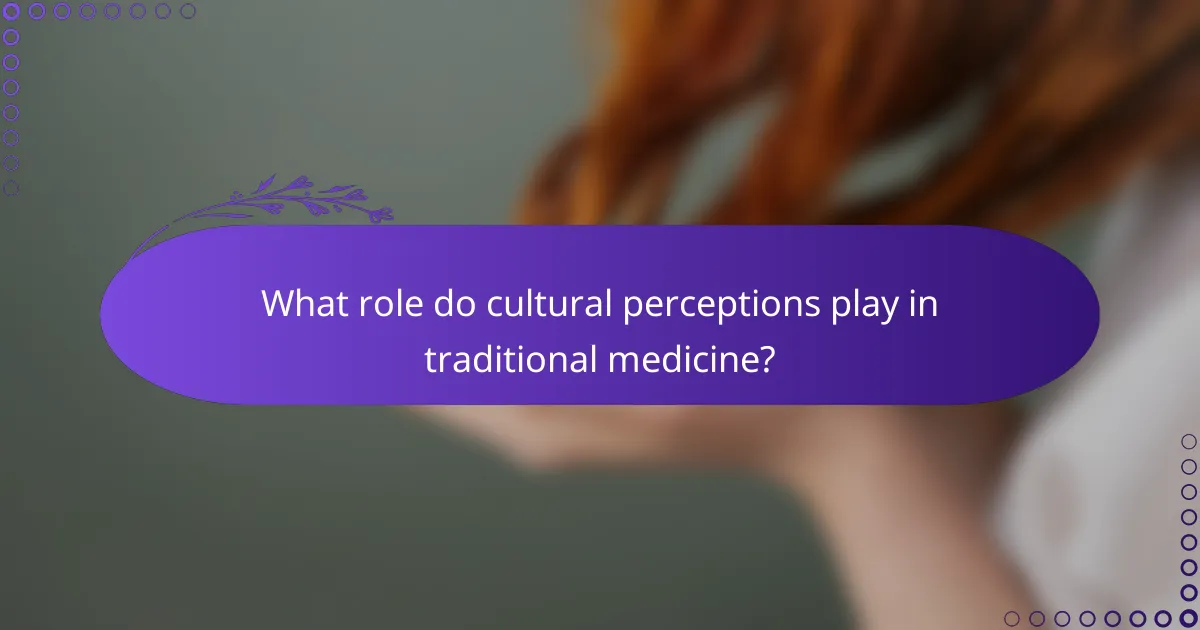
What role do cultural perceptions play in traditional medicine?
Cultural perceptions significantly influence traditional medicine by shaping beliefs about health, illness, and healing practices. These perceptions determine how individuals view the efficacy of various treatments and their willingness to engage with different medical systems.
Influence on treatment choices
Cultural beliefs often dictate the preferred treatment options individuals choose. For instance, in cultures where traditional herbal remedies are valued, patients may prioritize these over conventional pharmaceuticals. This preference can lead to a reliance on local practices, which may not always align with modern medical guidelines.
Moreover, the integration of traditional practices with modern medicine can vary widely. In some regions, healthcare providers may incorporate traditional remedies into treatment plans, while in others, there may be a strict separation. Understanding these dynamics is crucial for healthcare professionals working in multicultural environments.
Impact on patient trust
Cultural perceptions can significantly affect the level of trust patients have in healthcare providers. When practitioners respect and acknowledge traditional beliefs, patients are more likely to feel understood and valued, which enhances their trust in the medical system. Conversely, dismissing these beliefs can lead to skepticism and reluctance to follow medical advice.
Building trust involves effective communication and a willingness to discuss the benefits and limitations of both traditional and modern treatments. Healthcare providers should strive to create an inclusive environment that recognizes the importance of cultural perspectives in health and healing.

How do traditional medicine practices vary across different regions?
Traditional medicine practices differ significantly across regions, influenced by cultural beliefs, local resources, and historical contexts. Each system has unique methodologies and philosophies that reflect the values and needs of the communities they serve.
Ayurveda in India
Ayurveda, a holistic healing system originating in India, emphasizes balance among the body, mind, and spirit. It categorizes individuals into three primary doshas: Vata, Pitta, and Kapha, which dictate personalized treatment plans involving diet, herbal remedies, and lifestyle adjustments.
Practitioners often recommend specific herbs, such as Ashwagandha for stress relief or Turmeric for inflammation. Regular detoxification practices, like Panchakarma, are also integral to maintaining health and preventing disease.
Traditional Chinese Medicine in China
Traditional Chinese Medicine (TCM) is based on the concept of Qi (energy) and the balance of Yin and Yang. It employs various modalities, including acupuncture, herbal medicine, and Tai Chi, to restore harmony within the body.
Common practices include acupuncture sessions to alleviate pain and herbal formulas like Ginseng for energy enhancement. TCM also emphasizes preventive care, encouraging lifestyle changes to maintain balance and health.
Indigenous healing practices in North America
Indigenous healing practices in North America are diverse and deeply rooted in the spiritual and cultural traditions of various tribes. These practices often involve rituals, herbal remedies, and community support to address physical, emotional, and spiritual health.
Common elements include the use of plants like Sage and Sweetgrass for purification and the importance of ceremonies, such as sweat lodges, to foster healing. Practitioners often emphasize the interconnectedness of all life, promoting a holistic approach to well-being.
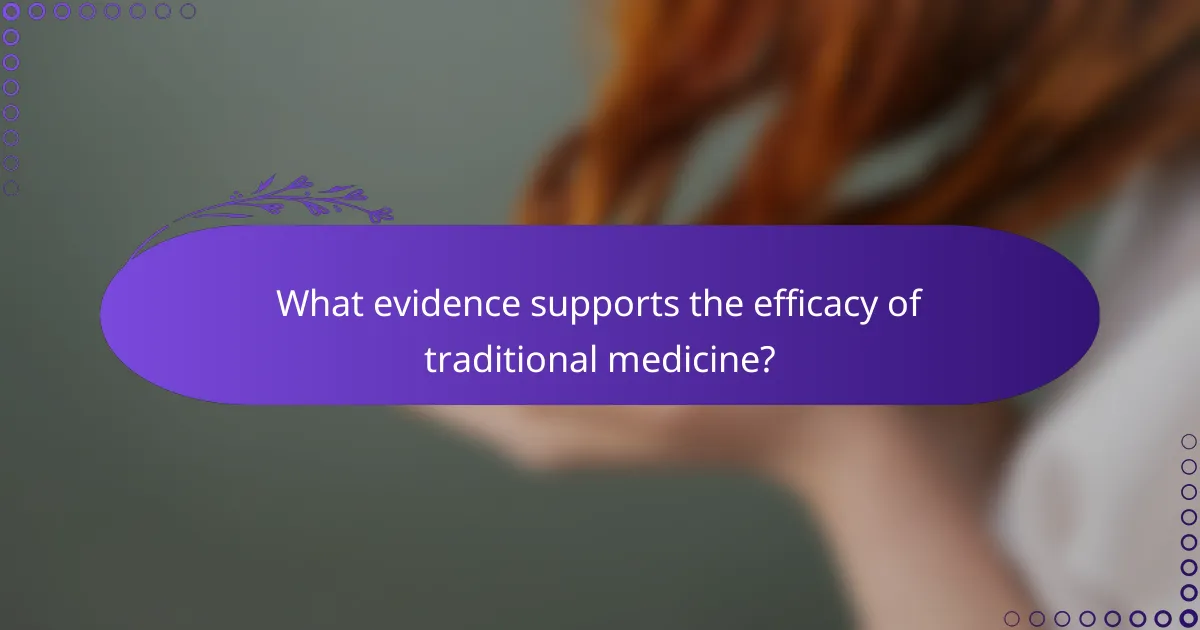
What evidence supports the efficacy of traditional medicine?
Evidence supporting the efficacy of traditional medicine includes clinical studies, meta-analyses, and patient testimonials. These sources provide insights into how various practices, such as herbal remedies and acupuncture, can effectively contribute to health and wellness.
Clinical studies on herbal remedies
Clinical studies have demonstrated the potential benefits of various herbal remedies in treating specific conditions. For instance, St. John’s Wort has been shown to be effective for mild to moderate depression, while ginger is often used for nausea relief. However, the quality of studies can vary, so it’s essential to consider the methodology and sample size.
When evaluating herbal remedies, look for studies published in reputable journals that adhere to rigorous standards. Be aware that some herbal products may interact with conventional medications, so consulting with a healthcare professional is advisable.
Meta-analyses of acupuncture
Meta-analyses of acupuncture research indicate that it can be effective for pain management and certain chronic conditions. These analyses compile data from multiple studies, providing a broader perspective on acupuncture’s efficacy. For example, acupuncture has been found beneficial for conditions like chronic back pain and migraines.
While acupuncture shows promise, results can vary based on individual responses and the skill of the practitioner. It’s important to seek licensed acupuncturists who are trained in established techniques to maximize potential benefits.
Patient testimonials and case studies
Patient testimonials and case studies often highlight personal experiences with traditional medicine, showcasing its impact on individual health journeys. Many individuals report significant improvements in their conditions after using herbal remedies or undergoing acupuncture treatments.
While these accounts can be compelling, they are subjective and may not represent the general population. It’s crucial to consider testimonials as part of a broader evaluation, combining them with scientific evidence and professional advice for informed decision-making.
